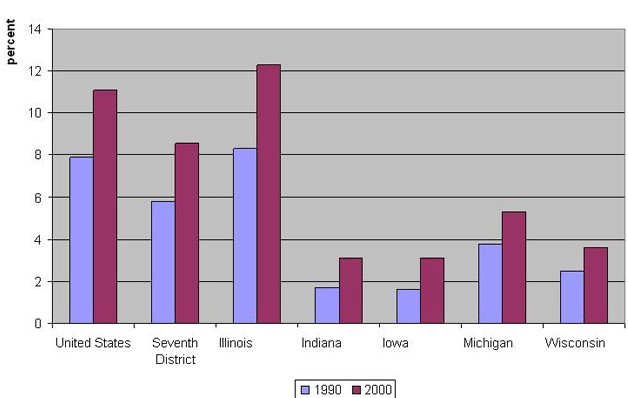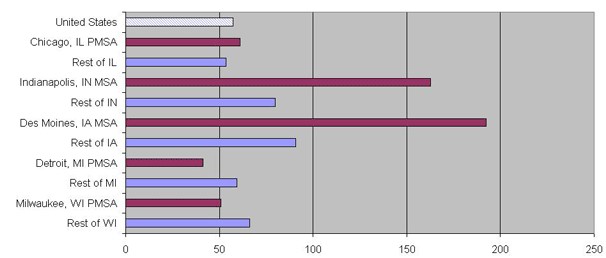Foreign born
The recent influx of foreign born into the United States has drawn attention on several public policy fronts. The U.S. Congress is currently considering a tighter border policy with Mexico, in part due to concerns of national security and the rule of law. In addition, the surge in foreign born (and their offspring) figures into debates over the sources of the widening wage and income disparities in the U.S. and in the slow growth of wage rates and income at the bottom of the income distribution.
On a more positive note, the foreign-born population is accounting for approximately one-third of U.S. population growth, somewhat more if the newborn children of recent immigrants are counted. The possible benefit of a more rapid population growth stems from the fact that the U.S. labor force market is already tightening rapidly and promises to tighten further as the “baby boom” generation retires. Slow growth of the work force can ultimately slow the overall pace of economic growth, especially if accompanied by slow growth of workers with specific skills. Indeed, for many regions, one key economic challenge and opportunity is to facilitate education and skills acquisition of the foreign born. As of 2005, the U.S. Department of Labor reports that 28 percent of the foreign born aged 25 years and older had not completed high school versus 7 percent for the native-born.
Prior to the 1990s, as shown by the chart below, the Seventh District region, which includes much or all of Illinois, Indiana, Iowa, Michigan and Wisconsin, had not attracted immigrants to the same extent as many other U.S. regions. Still, as shown by the second chart below, strong growth in immigration has taken place here in recent years. So too, the Chicago metropolitan statistical area (MSA) has remained an exceptionally strong magnet among metropolitan areas. Chicago ranked 5th in foreign-born population according to the 2000 Census of Population, with 17 percent to 18 percent of its population foreign born. And since that time, the Chicago metro area has ranked among the top 10 metro area gainers in numbers of both Asian and Hispanic population.
1. Foreign born as a percent of total population

Recent immigrants (as well as members of other ethnic and minority groups) are, to a greater extent, relocating to new areas of opportunity and high growth. According to recent report by demographer William Frey, “Hispanic and Asian populations are spreading out from their traditional metropolitan centers” and expanding their presence in new destinations, including suburbs and rural areas. In part, this dispersion may be an added impetus to current public policy attention concerning U.S. immigration and border control policies.
The chart below confirms for the Seventh District the dispersion of immigrants and foreign born. All Seventh District states experienced healthy growth of foreign-born population. However, the two states with the lowest proportions of foreign-born population—Iowa and Indiana—experienced the largest population growth rates over the decade of the 1990s at 110 and 98 percent respectively.
2. Percent change in foreign born population: 1990 to 2000

The Seventh District experience also confirms that immigrants are now following opportunities in employment and housing to a greater extent rather than simply following their historic well-worn path to the largest U.S. metropolitan areas and their central cities.
The final chart (below) distinguishes the growth in foreign born in each state’s largest metropolitan area from the rest of the state. In those large metropolitan areas where economic growth has been leading state economic growth and where unemployment is generally low, growth in the foreign-born population has exceeded the remainder of the state. This experience has particularly characterized the picture in Des Moines, Iowa, Indianapolis, Indiana, and Chicago, Illinois. In contrast, the Milwaukee, Wisconsin, and Detroit, Michigan metro area economies have both lagged their respective states and so have their respective growth rates of foreign born population.
3. Foreign born, percent change 1990 to 2000

In choosing their nation of destination, immigrants have in the past, “voted with their feet” in search of greater freedom and economic opportunity. Within that destination, immigrants often tended to follow well-worn paths, disembarking in cities and communities where their fellow immigrants had preceded them. In contrast, immigrants to the U.S. are today choosing to disembark directly where economic opportunities are greatest. For this reason, the growth rate of the foreign-born population has become yet another indicator in gauging the success of metropolitan areas.
How well immigrants adapt to their new communities, and how well communities adapt to them, will be part of the future equation of success or failure of many U.S. regions.








